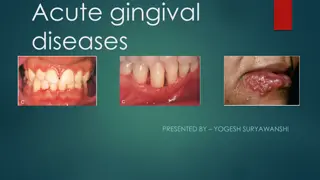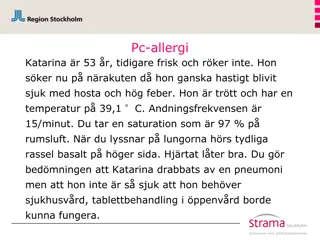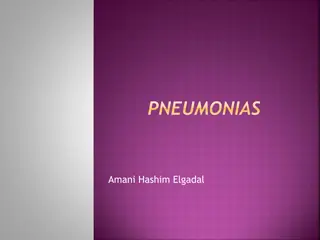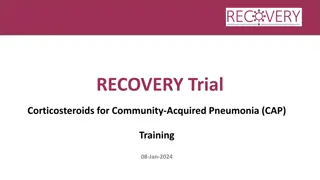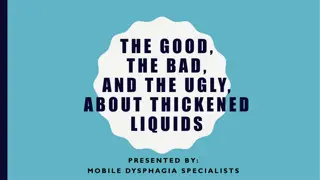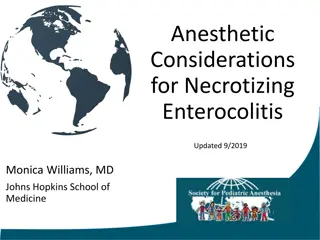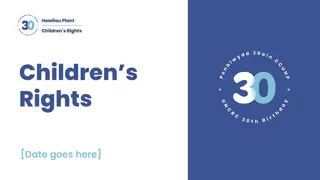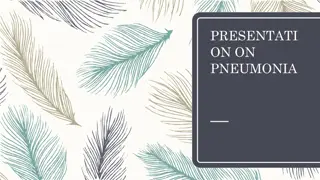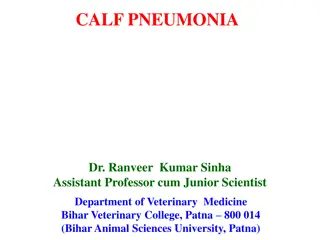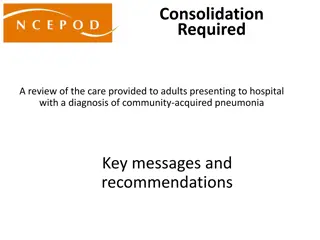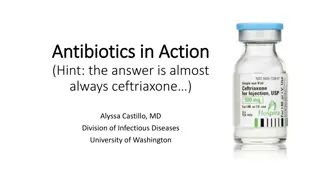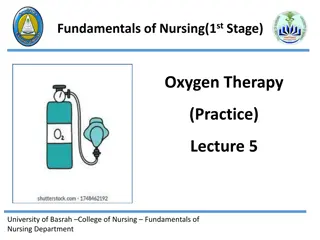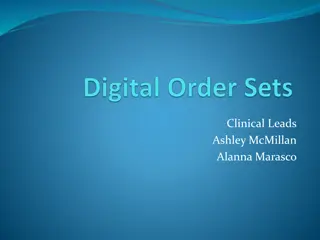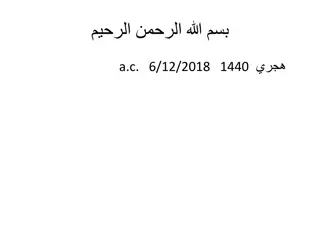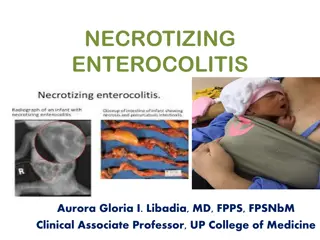Overview of Necrotizing Pneumonia in Children
Necrotizing pneumonia in children is characterized by necrosis of pulmonary tissue, leading to the formation of small cavities containing necrotic debris or fluid. Staphylococcus Aureus and Streptococcus Pneumoniae are common pathogens. Treatment involves a prolonged course of IV antibiotics tailored to local epidemiologic and microbiological data. Prompt recognition and management are crucial in minimizing complications.
Download Presentation

Please find below an Image/Link to download the presentation.
The content on the website is provided AS IS for your information and personal use only. It may not be sold, licensed, or shared on other websites without obtaining consent from the author.If you encounter any issues during the download, it is possible that the publisher has removed the file from their server.
You are allowed to download the files provided on this website for personal or commercial use, subject to the condition that they are used lawfully. All files are the property of their respective owners.
The content on the website is provided AS IS for your information and personal use only. It may not be sold, licensed, or shared on other websites without obtaining consent from the author.
E N D
Presentation Transcript
NECROTIZING PNEUMONIA IN CHILDREN Dr Truong ThiThanhThao
CONTENTS CONTENTS Definition Pathogens Treatment Conclusions
DEFINITION DEFINITION Necrotizing pnemonia is defined as necrosis of the pulmonary tissue and formation of lolitary or multiple small cavities(<2 cm) containing necrotic debris or fluid.
(G.S. Sawicki,+, F.L. Lu,+, C. Valim, R.H. Cleveland" and A.A. Colin. Necrotising pneumonia is an increasingly detected complication of pneumonia in children. Eur Journals Ltd 2008)
PATHOGEN PATHOGEN
Staphylococcus Aureus and Streptococcus Pneumoniae are the main agents.
TREATMENT TREATMENT A prolonged course of IV antibiotics is the cornerstone. The initial choice of antibiotics base on local epidemiologic and microbiological results.
+Staphylococcus Aureus Panton Valentine Leukocidin (+) +Anaerobic
51% were documented +Staphylococcus Aureus ( 61,9%) (all Panton Valentine Leukocidin positive) +Streptococcus Pneumoniae ( 33,3%) +Anaerobic (4,8%)
April to June 2017 Total :281 cases Staphylococcus Aureus MRSA (+) : 83%
Clindamycine, Rifampicine, Linzolide, acid fusidic : inhibit PVL (+) S. Aureus Panton-Valentine Leukocidin in the Pathogenesis of Community-associated Methicillin-resistant Staphylococcus aureus infection;Wen-Tsung Lo, Chih-Chien Wang Department of Pediatrics, Tri-Service General Hospital, National Defense Medical Center, Taipei, Taiwan. Received May 17, 2010; Elsevier Jun 22, 2010
Initial treatnent like complicated CAP Ceftriaxone 100 mg/kg IV in two divided doses up to a maximum dose of 4 g/day, OR Cefotaxime 150 mg/kg per day IV in four divided doses up to a maximum of 10 g/day, PLUS Clindamycin 30 to 40 mg/kg per day IV in three or four divided doses to a maximum of 1 to 2 g/day if S. aureus or anaerobes are a consideration. Vancomycin 40 to 60 mg/kg per day IV in three or four divided doses up to a maximum of 4 g/day is an alternative to Clindamycin if the patient is allergic to clindamycin or if clindamycin-resistant S. aureus is prevalent in the community. [uptodate2017]
The duration is determined by the clinical response but is usually a total of four weeks or two weeks after the patient is afebrile and has improved clinically. [uptodate2017]
Role of surgery on NP Role of surgery on NP Surgical intervention for NP should be avoided as NP usually has an excellent outcome in children. (B-II). (American Pediatric Surgical Association)
The suggestion is based on the evidence that drainage of necrotic lung tissue actually led to the development of bronchopleural fistula.
COMLICATIONS COMLICATIONS SEPSIS , SEPTIC shock Pleural effusion/Empyema Pneumothorax Bronchopleural fistula Pneumatocele
OUTCOME OUTCOME
Long-term clinical outcomes are excellent. Pulmonary function testing had essentially normal result. Chest radiographs and CT scans have shown almost complete normalisation of pulmonary parenchyma. (G.S. Sawicki,+, F.L. Lu,+, C. Valim, R.H. Cleveland" and A.A. Colin. Necrotising pneumonia is an increasingly J, Bonacorsi S, Naudin J, et al. Necrotizing pneumonia in children. Redetected complication of pneumonia in children. Eur Journals Ltd 2008)
Mortality: 6/261 (2,3%) (Danial Wai-Tai KO, Review on paediatric necrotising pneumonia and its pulmonary co-morbidities, Journal of Paediatric Respirology and Critical Care, December 2014)
CONCLUSION CONCLUSION Necrotizing pneumonia is the complication of pneumonia in children. Pathogens: Staphylococcus Aureus (MRSA-PVL(+)) Streptococcus Pneumoniae Anaerobic Antibiotic is the main therapy (Clindamycin) Duration of treatment : 4 weeks or 2 weeks after the patient is afebrile and has improved clinically. Surgical intervention for NP should be avoided.
Reference Reference Uptodate 2017 Liu, C., et al., Clinical practice guidelines by the infectious diseases society of america for the treatment of methicillin- resistant Staphylococcus aureus infections in adults and children. Clin Infect Dis, 2010 G.S. Sawicki,+, F.L. Lu,+, C. Valim, R.H. Cleveland" and A.A. Colin. Necrotising pneumonia is an increasingly J, Bonacorsi S, Naudin J, et al. Necrotizing pneumonia in children. Redetected complication of pneumonia in children. Eur Journals Ltd 2008 Lemaitre C, Angoulvant F, Gabor F, Makhoul port of 41 cases between 2006 and 2011 in a French tertiary care center. Pediatr Infect Dis J. 2013. Tsai Y-F, Ku Y-H. Necrotizing pneumonia: a rare complication of pneumonia requiring special consideration. Curr Opin Pulm Med. 2012 L. L pez Gonz lez, I. Herr ez Ortega, L. Gonz lez Pastrana, E.Zorita Arg ero, C. Cordero Lares, R. Management of necrotizing pneumonia in children. ECR 2012 Kyung Mi Park,1Seung Kook Son,1Hye-Young Kim,1Yong-Woo Kim,2Jae-Yeon Hwang. and Hee Ju Park. Clinical features of necrotizing pneumonia in children. Allergy Asthma Respir Dis. 2014 Jul. F. A.Hoffer, D. A.Bloom, Andrew A.Colin, Steven J.Fishman. Lung abscess versus necrotizing pneumonia: implications for interventional therapy, January 1999 Danial Wai-Tai KO, Review on paediatric necrotising pneumonia and its pulmonary co-morbidities Bradley JS, Byington CL, Shah SS, Alverson B, Carter ER, et al. Pediatric Infectious Diseases Society and the Infectious Diseases Society of America. The management of community-acquired pneumonia in infants and children older than 3 months of age: clinical practice guidelines by the Pediatric Infectious Diseases Society and the Infectious Diseases Society of America. Clin Infect Dis 2011


